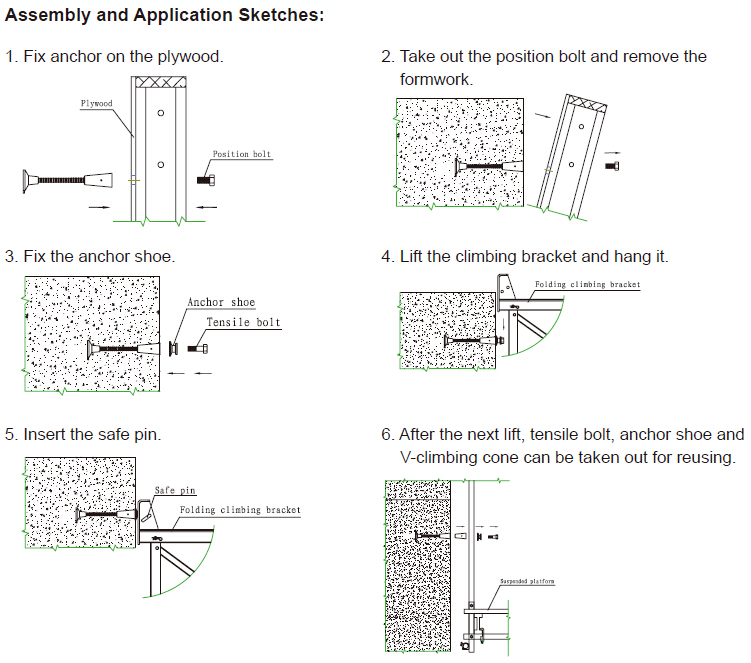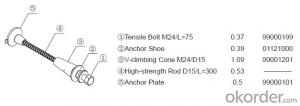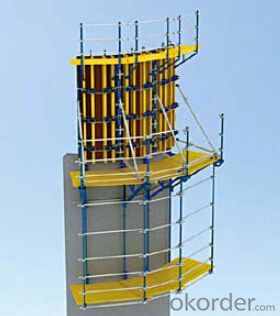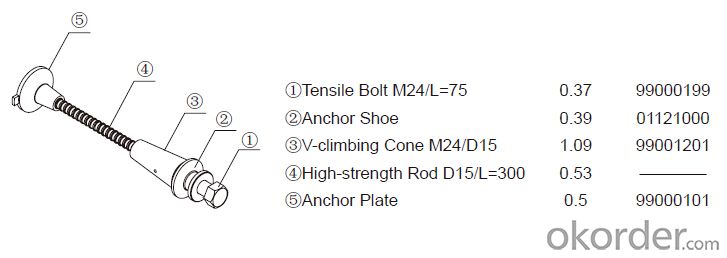Climbing Platform CP190 for Formwork and Scaffolding System
- Loading Port:
- Tianjin
- Payment Terms:
- TT OR LC
- Min Order Qty:
- 50 m²
- Supply Capability:
- 1000 m²/month
OKorder Service Pledge
OKorder Financial Service
You Might Also Like
Climbing Platform CP190
Climbing bracket CP190 is mainly used as operating platform during construction. It can be used
on the vertical wall and arced wall. The bracket hang on the anchor system and all the load are
supported by anchor system. It’s convenient to assemble and dismantle, the construction is easy,
rapid and safe.
Anchor System:
Anchor system is the most important supporting part. The system is made of five parts shown
below. There into, tensile bolt, anchor shoe and V-climbing cone can be taken out for reusing.

- Q: How is steel formwork supported during concrete pouring?
- Steel formwork is supported during concrete pouring through a system of props, beams, and scaffolding. Props are vertical supports that are strategically placed beneath the steel formwork to provide stability and prevent any sagging or collapsing under the weight of the wet concrete. These props are typically adjustable, allowing for precise positioning and leveling of the formwork. In addition to props, horizontal beams are used to provide further support to the steel formwork. These beams are usually placed at regular intervals and are connected to the props, creating a sturdy framework that can withstand the pressure exerted by the concrete. The beams also help distribute the load evenly across the formwork, ensuring that it remains balanced and secure. Scaffolding is another crucial component in supporting steel formwork during concrete pouring. It is erected around the formwork to provide a safe working platform for workers to access and maneuver the formwork. Scaffolding also assists in the installation and removal of the formwork, enabling efficient construction processes. Overall, the combination of props, beams, and scaffolding plays a vital role in supporting steel formwork during concrete pouring. This support system ensures that the formwork remains stable, allowing the concrete to be poured and cured accurately, resulting in a strong and durable structure.
- Q: How does the cost of steel formwork compare to other types of formwork?
- The cost of steel formwork is generally higher compared to other types of formwork such as wood or plastic. This is primarily due to the higher material and manufacturing costs associated with steel. However, steel formwork offers several advantages such as durability, reusability, and greater load-bearing capacity, which can offset the higher initial cost in the long run.
- Q: Can steel formwork be used in marine construction projects?
- Yes, steel formwork can be used in marine construction projects. Steel formwork is a durable and versatile construction material that can withstand the harsh conditions of marine environments such as saltwater, waves, and corrosion. It is often used in marine construction projects for various applications such as building piers, docks, seawalls, and other structures that require a strong and stable foundation. Steel formwork provides excellent structural support and can withstand the heavy loads and pressures associated with marine construction. Additionally, steel formwork can be easily assembled and disassembled, making it a practical choice for marine construction projects where time and efficiency are crucial. Overall, steel formwork is a reliable and suitable option for marine construction projects.
- Q: How does steel formwork handle concrete shrinkage and cracking?
- Steel formwork is a versatile and durable option when it comes to dealing with concrete shrinkage and cracking. Its design ensures support and stability during the pouring and curing process, effectively minimizing the negative effects of shrinkage and cracking. One of the main benefits of steel formwork is its capacity to withstand the pressure exerted by shrinking concrete. Steel is a resilient material that can resist the forces generated by the drying and hardening of the concrete. As a result, the formwork remains intact and does not deform or collapse under the weight of the shrinking concrete. Moreover, steel formwork often incorporates expansion joints or other flexible components that can accommodate the movement caused by shrinkage and cracking. These joints allow the formwork to expand and contract in sync with the concrete, reducing stress on the structure and minimizing the risk of cracks. Additionally, steel formwork can be easily reinforced or supplemented with additional support elements, like braces or tie rods, to further enhance its ability to handle concrete shrinkage and cracking. These reinforcements ensure the forces exerted by the shrinking concrete are evenly distributed across the formwork, decreasing the likelihood of localized cracking or structural failure. In summary, steel formwork is a reliable and robust solution for effectively managing concrete shrinkage and cracking. Its strength, flexibility, and capacity for reinforcement make it an ideal choice for construction projects where minimizing the impact of these issues is of utmost importance.
- Q: How does steel formwork perform in fire-resistant structures?
- Fire-resistant structures benefit greatly from the exceptional performance of steel formwork. Steel possesses inherent properties, including a high melting point and strength, which make it an ideal material for withstanding high temperatures and maintaining structural integrity in the event of a fire. To begin with, steel formwork exhibits non-combustible characteristics, meaning it does not contribute to the spread or intensity of a fire. Unlike certain construction materials, it does not burn or release harmful gases when exposed to flames. This quality aids in preventing the rapid propagation of fire within the structure, affording valuable time for evacuation and fire suppression efforts. Furthermore, steel possesses a high melting point in comparison to other commonly used formwork materials such as wood or plastic. This attribute enables steel formwork to retain its structural integrity even when subjected to intense heat. It can endure temperatures well above 1000°C (1832°F) without significant deformation or collapse, ensuring the stability of the structure and minimizing the risk of sudden structural failure during a fire. Moreover, steel formwork exhibits excellent load-bearing capabilities, even under high temperatures. This characteristic is crucial in fire-resistant structures as it allows the building to maintain its structural capacity when exposed to fire. The ability of steel formwork to bear the weight of the structure, even when compromised by fire, helps prevent structural collapse and ensures the safety of occupants and emergency personnel. Additionally, steel formwork is known for its durability and longevity, which are essential qualities in fire-resistant structures. It can withstand the effects of fire, such as thermal expansion and contraction, without sustaining significant damage. This durability ensures that the formwork can be reused or remain in place for future fire events, providing ongoing fire protection for the structure. In conclusion, steel formwork demonstrates exceptional performance in fire-resistant structures. Its non-combustible nature, high melting point, load-bearing capabilities, and durability make it a reliable choice for maintaining the structural integrity and safety of the building in the event of a fire.
- Q: How is steel formwork assembled and disassembled?
- Efficient construction processes are ensured by systematically and sequentially assembling and disassembling steel formwork. The foundation preparation marks the start of the assembly process, where the steel formwork components are arranged to match the desired shape and dimensions of the structure. To assemble the steel formwork, the first step involves connecting the vertical and horizontal components using various connecting devices like pins, bolts, or clips. These components, including panels, walers, and soldiers, are interlinked to create a rigid framework that offers the necessary support and shape for the concrete structure. Once the initial framework is assembled, the next step includes placing form ties or clamps that firmly secure the formwork panels in place. These ties or clamps are inserted through holes in the panels and tightly fastened on the opposite side to prevent any movement during the pouring and curing of the concrete. After the concrete has been poured and cured, the disassembly process begins. This process is carried out in reverse order, starting with removing the form ties or clamps. Once these are taken out, the formwork panels can be easily detached from the framework, allowing for the removal of the soldiers and walers. The disassembly of steel formwork also involves carefully dismantling the vertical and horizontal components, ensuring no damage is done to the framework or the panels. This is achieved by removing the connecting devices, such as pins, bolts, or clips, and systematically disassembling the various components. It is crucial to note that only experienced and trained professionals should handle the assembly and disassembly of steel formwork to guarantee safety and avoid any potential accidents or structural failures. Adhering to proper procedures and guidelines is essential for the successful completion of a construction project that utilizes steel formwork.
- Q: How does steel formwork handle formwork stability during concrete pouring?
- Steel formwork provides excellent formwork stability during concrete pouring due to its high strength and rigidity. It can withstand the pressure and weight of the fresh concrete without deformation or collapse, ensuring the desired shape and structure of the concrete elements. Additionally, steel formwork can be easily adjusted and secured in place, allowing for precise alignment and stability during the pouring process.
- Q: How does steel formwork prevent concrete bleeding?
- Steel formwork is a type of temporary structure that is used in construction to hold and shape the concrete until it sets and hardens. One of the advantages of using steel formwork is that it can help prevent concrete bleeding, which is the process of water separating from the mixture and rising to the surface. Steel formwork is typically designed with tight joints and smooth surfaces, which helps to create a watertight seal around the concrete. This prevents water from seeping out of the mixture and rising to the surface, reducing the occurrence of concrete bleeding. Additionally, the rigid nature of steel formwork prevents the concrete from settling or shifting during the pouring process, further minimizing the potential for bleeding. Furthermore, steel formwork offers better stability and durability compared to other types of formwork materials. Its rigid structure ensures that the formwork remains intact and maintains the desired shape during the concrete pouring process, preventing any movement that could lead to bleeding. In conclusion, steel formwork prevents concrete bleeding by providing a tight seal, stability, and a smooth surface. These features prevent water from separating from the mixture and rising to the surface, resulting in a higher quality and more visually appealing concrete finish.
- Q: Can steel formwork be used for earthquake-resistant concrete buildings?
- Yes, steel formwork can be used for earthquake-resistant concrete buildings. Steel formwork refers to the temporary structure used to hold and shape the concrete until it sets and hardens. It is known for its strength, durability, and ability to withstand high loads, which are desirable characteristics in earthquake-resistant construction. During an earthquake, buildings are subjected to lateral forces and vibrations. Steel formwork, being strong and rigid, can help in distributing and transferring these forces throughout the structure. It provides the necessary support to ensure the concrete walls, columns, and slabs remain intact during seismic events. Additionally, steel formwork allows for precision and accuracy during the construction process. This is crucial in earthquake-resistant buildings as any deviation from the intended design can weaken the structure's ability to withstand seismic forces. The use of steel formwork ensures that the concrete components are properly reinforced with steel bars and that all necessary connections and joints are correctly placed. Furthermore, steel formwork can be easily assembled, disassembled, and reused, making it a cost-effective solution for earthquake-resistant construction projects. This allows for efficient construction practices, reduces waste, and enables the formwork to be used for multiple projects, making it an environmentally friendly choice. However, it is important to note that while steel formwork is an essential component in earthquake-resistant concrete buildings, it is not the only factor that determines the overall structural integrity. Other design considerations such as proper reinforcement detailing, adequate foundation design, and appropriate structural analysis are equally important. In conclusion, steel formwork can be effectively used for earthquake-resistant concrete buildings due to its strength, durability, and ability to withstand seismic forces. However, it should be complemented with proper design and construction practices to ensure the overall structural resilience and safety of the building.
- Q: Can steel formwork be custom-made?
- Yes, steel formwork can be custom-made to suit specific project requirements and dimensions. The flexibility of steel allows for customization in terms of shape, size, and design, making it a popular choice for construction projects that require unique or complex formwork solutions.
Send your message to us
Climbing Platform CP190 for Formwork and Scaffolding System
- Loading Port:
- Tianjin
- Payment Terms:
- TT OR LC
- Min Order Qty:
- 50 m²
- Supply Capability:
- 1000 m²/month
OKorder Service Pledge
OKorder Financial Service
Similar products
Hot products
Hot Searches
Related keywords




















